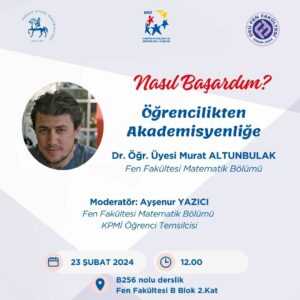Matthias Täufer, Analysis group, FernUniversität in Hagen, Germany Tarih: 01 Mart 2024, Cuma Zaman: 13:00 Yer: Matematik Bölümü B255 nolu derslik
Özet: Unique continuation is a basic property of many partial differential equations stating that solutions vanishing on subsets must be identically zero. In many cases one would like to have a quantitative version of that, meaning that one can bound the norm of solutions by their norm on subsets. In this talk, we review some history of quantitative unique continuation and present several results on quantitative unique continuation in unbounded domains. Based on joint works with Ivica Nakic (Zagreb), Martin Tautenhahn (Leipzig), Sedef Özcan (Dokuz Eylül), Paul Pfeiffer (Hagen), Albrecht Seelmann (Dortmund) and Ivan Veselic (Dortmund).
